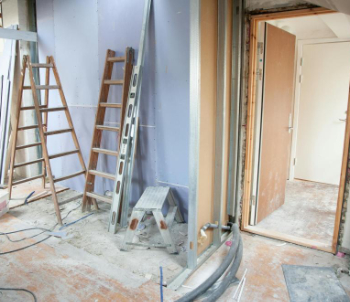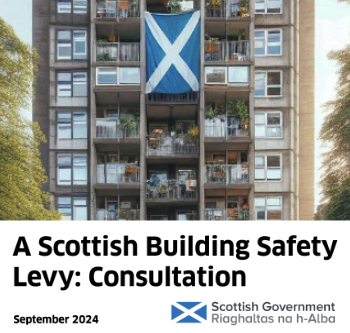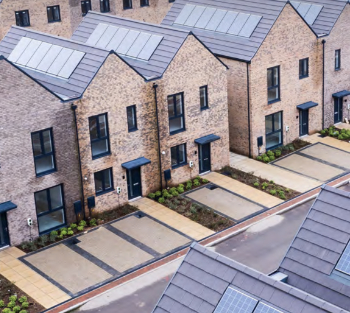Industry leaders respond to Future Homes and Buildings Standards
[edit] GHA and Bioregional, in partnership with the LETI and UKGBC express disappointment in proposed Future Homes and Buildings Standard
In a significant demonstration of industry concern, a joint letter expressing disappointment over the proposed Future Homes and Buildings Standard has been sent to the Department for Levelling Up, Housing, and Communities (DLUHC).
Drafted collaboratively by the Good Homes Alliance (GHA) and Bioregional, in partnership with the Low Energy Transformation Initiative (LETI) and the UK Green Building Council (UKGBC) and other organisations, the letter bears the signatures of 250 prominent industry and community leaders.
Despite some positive aspects, the Future Homes Standard consultation has drawn criticism from a wide spectrum of industry organsations. The signatories, representing a diverse array of stakeholders ranging from developers and local authorities, to consultants and architects, emphasise the imperative of a higher standard which address the pressing challenges of building the sustainable, healthy homes with low bills needed.
The unified call for action demands further collaboration to deliver a fit-for-purpose proposal, advocating for measures that prioritise energy efficiency, carbon reduction, and resilience for new build housing. Signatories urge DLUHC to engage in substantive dialogue with industry stakeholders to set out future iterations of the standard and ensure its efficacy in advancing sustainability.
Sue Riddlestone OBE, co-founder and CEO of Bioregional said
“The industry, including mainstream housebuilders, were expecting something more coherent from the government than the two options in the FHS consultation. DLUHC’s reasoning behind the proposals is that firstly, higher standards will impact housing supply. They won’t! They can be factored into training and land values. Secondly, the consultation states that it will be cheaper to decarbonise the grid, but provides no evidence, at a time when grid electricity needs to grow fourfold by 2050. There is a huge amount of goodwill and experience in the sector, we stand ready to support policymakers to create a fit for purpose FHS.”
Lynne Sullivan OBE, Chair of Good Home Alliance said
“In recent months new reports have again evidenced the poor quality of UK’s new homes but the FHS proposals fall far short of our expectations for better fabric and post construction testing, to deliver consumer confidence in solving issues of mould growth and condensation and certainty of low running costs. Aside from the switch to low carbon heating, by failing to deliver on these - and their promises to tackle embodied carbon of materials – DLUHC’s proposals for a standard fit for our 2050 goals are inadequate.”
Read the letter and see the list of signatories here https://goodhomes.org.uk/future-home- standard-response-1.
This article was issued via Press Release as "INDUSTRY LEADERS CALL FOR MORE AMBITION IN THE PROPOSED FUTURE HOMES STANDARD" dated March 27, 2024.
[edit] CIC calls on government to improve plan for climate resilient homes
The Construction Industry Council (CIC) has responded to the Future Homes and Buildings Standards consultations, calling on government to accelerate the future proofing and decarbonisation of homes.
It has urged that government must work with industry to support the necessary upskilling needed to achieve this and provide guidance not only for tradespeople and designers but to consumers who will be unfamiliar with some of the new technologies deployed.
CIC's response emphasised:
- Support for post-occupancy evaluations and the use of a delivered energy metric which can create a feedback loop with the design predictions.
- Disappointment that the measurement of embodied carbon is not being considered as part of this consultation given that embodied carbon could make up 70% of a new home's whole-life carbon.
- The need for a parallel government strategy is to ensure that appropriate, accredited and trained professionals are available to properly oversee the installation – and maintenance – of energy saving measures such as heat pumps.
- Strong support for the plans to make a definitive switch away from fossil-fuel heating plans but concerns that the options given in the consultation were not aspirational enough.
- The importance of improving standards for homes converted through Permitted Development – particularly on areas such as overheating – and the need for owners and residents to have the same information about their home as buyers of wholly new-build homes.
The Future Homes Standard and Future Buildings Standard is part of the government's plan to improving the energy efficiency and reducing the carbon emissions of new homes and non-domestic buildings. The consultation set out the plans for achieving the Standard including technical proposals for changes to the Building Regulations, the associated Approved Document guidance and calculation methods. As well as covering new homes and non-domestic buildings, some sections are relevant to existing buildings including those on material change of use, real-world performance of homes and Part O which addresses overheating.
Professor Stephen Hodder, CIC Climate Change Committee Chair, said:
This Standard is likely to be the government's legacy and having waited so long we need to ensure that we get it right as we could be building or converting millions of homes under the proposals. These homes are likely to see the worst impacts of climate change and will need to be robust and resilient through this, and therefore they need to be future-proof or at least adaptable.
Professor Tony Crook, Chair of CIC's Housing Panel, added:
We support high quality retrofit and this extends to materials change of use, which can also mean less construction waste and lower whole-life carbon. But homes created in this way need to be safe, sustainable and nurture sustainable communities. We do not need homes that will be obsolete in a decade's time because the structure is unsound and the conversion has been carried out in a way that puts resident's health at risk.
Inactivity on energy efficiency has been costly for consumers in terms of rising bills, yet robust measures to improve this could also help the public purse, with BRE reporting that investments to improve some of the worst quality homes could save the NHS around £1.4bn in first year treatment costs alone. We urge government to seize the opportunity to create a positive housing legacy.
This article appears on the CIAT news and blog site as "CIC calls on government to improve plan for climate resilient homes" dated April 4, 2024.
[edit] CIH response to the Future Homes Standard technical consultation
Introduction and summary
The Chartered Institute of Housing (CIH) is the professional body for people who work or have an interest in housing. We welcome the opportunity to respond to the Department for Levelling Up, Housing and Communities’ (DLUHC) technical consultation on the Future Homes Standard.
In the last ten years, government data shows that over 100,000 homes have been built that are EPC Band D or below, and will require retrofitting under current EPC measurement. We therefore warmly support the ambition of the Future Homes Standard and its intention of ensuring that no new homes are built with fossil fuel heating or will require retrofitting to be zero carbon in the future. The Future Homes Standard is also critical to tackling fuel poverty and ensuring that current and future generations have homes to live in that are warm, safe, affordable, accessible and decent.
In preparing our response to this consultation, we have consulted extensively with CIH members working in a range of different roles in the housing sector. This includes CIH members working in interlinked areas of housing supply and development; sustainability and net zero; and policy in housing associations, local authorities, and the private sector. The Future Homes Standard cuts across all of these areas, and has significant implications for housing policy, understood in its broadest sense. We have also consulted with other partner organisations across the housing, energy, and built environment sectors to inform our view. Accordingly, we have only responded to those questions where we can offer an informed and evidence-based response, and hope that the evidence we have provided can support the finalisation and implementation of the Future Homes Standard. We have responded to individual questions below, but our main points across our response are:
- Of the two performance specifications presented in the consultation document, we prefer Option 1 in both the main national building specification and the specification for buildings connected to heat networks. Option 2 would constitute a missed opportunity to tackle fuel poverty, especially for social housing residents, because of the higher heating and hot water bills relative to Option 1 and the Part L 2021 uplift. However, feedback from our members has suggested that DLUHC should also consider additional contender specifications (3-5) detailed by the Future Homes Hub’s Ready for Zero report, and we would encourage DLUHC to consider proposals that might be put forward by other organisations in response to this consultation.
- We have reservations about the real-world accuracy of the costings presented in the impact assessment. Feedback from CIH members suggests the capital cost uplift for developers associated with Option 1 (£6,200/4 per cent) is not reflective of estimated real-world costs for meeting the specification, which are estimated to require a capital cost uplift of £10,000-£15,000. The calculation of EANDCB costs over 10 years is also misaligned with the calculation of repair and maintenance costs in the social housing sector, which are undertaken over a longer time period. Given the wider financial pressures facing the social housing sector, it is imperative that the modelled capital cost uplift is as accurate as possible and reflected in future grant rates for affordable housing.
- We support the extension of Part O and a whole-dwelling standard to homes created through material change of use. These homes can often be poor quality, with government data and independent research evidencing low levels of energy efficiency that places their occupants at significant risk of excess cold and excess heat hazards. Material change of use can play a meaningful role in providing good quality, energy efficient homes, but only if these standards are introduced.
- We agree that the Home Energy Model should be adopted as the approved calculation methodology to demonstrate compliance of new homes with the Future Homes Standard.
- While we broadly agree with the updated Section 10 of Approved Document L, Volume 1: Dwellings, we have concerns that the provision of documentation is not sufficient to ensure that everyone can use and operate their heat pumps and low- carbon technologies optimally. We would welcome the development of research, good practice, and non-statutory guidance to ensure that, on request, people can receive personalised, accessible, and tailored support to use their heat pumps and low-carbon technologies effectively.
- We support a longer transitional period to give the social housing sector the time it needs to adapt to the new regulations. CIH members have told us that 18 months is too short a timeframe to adjust internal business plans and policies to meet the Future Homes Standard, and that a longer transitional period will enable design assessments and development pipelines to be fully compliant. In addition, clear guidance, support, and the timely laying of regulations in 2024 will be essential for giving the sector clarity on the changes it needs to make, and by when.
- The introduction of new regulations and associated obligations will create several new roles and responsibilities that local authorities and housing associations, as well as other actors in the housing sector, will need to fulfil. They will need to be resourced appropriately to be able to meet any changes brought in as a result of the consultation, including those associated with ensuring compliance.
- We have provided some evidence in response to the questions on Part O, specifically on:
- The increased overheating risk in homes with extensions or conservatories which is apparent through existing research.
- Amendments to Appendix C in Part O, which we feel should be expanded to cover a larger geographical area than some parts of London and Manchester.
- The need for a further call for evidence on Part O at a later date, to give relevant staff in the housing sector more time to assess the real-world application of Part O to their developments.
- The need to consider occupant vulnerability in overheating policy more generally.
- Lastly, we would encourage DLUHC to move forward with parallel work to mandate Part M 4(2) of the Building Regulations as the minimum standard in all new homes.
We would also like to make two broader points. Firstly, our priorities for the new specification are low capital cost, lower bills, and carbon savings. We do not agree with the way these are set out in the consultation as competing priorities that must be rated. These priorities can all be met if government commits to a long-term plan for housing that tackles the undersupply of affordable housing in England. The timescale and transitional arrangements for the Future Homes Standard will provide sufficient time for a long-term plan to be established to meet these priorities. Accordingly, instead of considering Future Homes Standard specification options that will cost less but place more residents at risk of fuel poverty, and/or introducing exceptions that will increase the risk of poor quality, energy inefficient homes being developed en masse, we support the establishment of a genuinely long-term plan for housing that can enable the social housing sector to deliver more decent, safe, accessible, and affordable homes for social rent.
Secondly, however they are finalised, the Future Homes Standard regulations will represent a significant change for the housing sector. The sector, especially housing associations and local authorities, will require clear guidance and support to be able to comply with the new regulations, including on how the regulations will affect standards for future homes and buildings that have been (or may be) adopted as local plan policy requirements. We would welcome the opportunity to work with DLUHC to ensure our members are prepared for the new regulations and can implement changes across their organisations to meet them.
he full CIH response to The Future Homes and Buildings Standards can be viewed here.
This article was issued via Press Release as "CIH response to the Future Homes Standard technical consultation" dated March, 2024.
[edit] RIBA Consultation response: Future Homes Standard
This consultation sets out technical proposals for changes to the Building Regulations, the associated Approved Document guidance and calculation methods.
Our response urged Government to use operational energy as the principal metric for measuring energy efficiency, raise fabric standards, strengthen requirements for material change of use dwellings, require Post Occupancy Evaluation for new homes, and bring forward the promised consultation on embodied carbon.
Read full RIBA response to The Future Homes and Buildings Standards here.
This section appears on the RIBA knowledge and resources pages as "The Future Homes and Buildings Standards: 2023 consultation" dated March 2024
[edit] BRE Group response to Future Homes Standard consultation
In order to tackle our climate challenge, we must capitalise on consumers’ desire for more sustainable, safe, quality homes and a changing market where the financial sector are playing a key role. Policy should have a clear minimum, but equally encourage innovation to go above and beyond, bringing new technologies and techniques. It should look at this holistically ensuring that homes work for our changing demographics but are also safe, resilient, secure and affordable. Getting this right will mean that the people have the best homes they can to live in and it will create a strong baseline to export skills, knowledge and products globally.
Summary
We think the current proposal falls short of delivering this as it is likely to encourage a culture of design for compliance rather than encouraging performance. A true Future Homes Standard should not only be considered in relation to Building Regulations. Our solution is that a Government supported holistic framework covering key sustainability issues is made available much sooner than the proposed timetable for regulations. This framework can be used by other Government levers such as procurement via Homes England, or as part of criteria for a renewed Help to Buy and also for planning purposes.
Market Context
Importantly such a framework can also be used by private investors, lenders and others who can help the market get to Zero Carbon much sooner. The rapid evolution of Green Finance requirements means that the consumers of the future are likely to be penalised by lenders (via higher mortgage rates) for homes which are considered to be poor performing in terms of sustainability.
New homes should be a force for good, they should be something that people want, and people want in their communities. Creating market pulls for more high quality, truly sustainable new homes will also encourage greater improvements in our existing housing stock, potentially using similar mechanisms, financial drivers and frameworks.
Planning has a role to play in this as it often sows the seed of good ideas and an early stage. This is important because investors that want higher levels of energy efficiency and may not be involved in the process at this stage. An example we have been made aware of includes cases where investors have ensured developers have delivered on their Code for Sustainable Homes requirements from planning. However, this must be within a framework not to create confusion or inefficiencies within the system that discourage innovative ways of development.
Regulations or Aspiration?
We welcome the published details of the Future Homes Standard as a trajectory to future iterations of Part L. However, in order to live up to its name the scope of the standard would need to be significantly evolved to issues which we understand to be outside the requirements of the Building Act 1984 as amended. Minimum standards within Building Regulations should be just that – minimum requirements – not an aspiration. By calling Building Regulations a “Future Homes Standard” it suggests that it is an aspiration. Aspiration is exactly what the sector needs, but without a holistic framework for different stakeholders to work to, opportunities are being lost.
BRE Solution
BRE, working with others, would be happy to support the further development of a true Future Homes Standard that includes issues such as embodied carbon and those to support our ageing population that provides a stretch to the sector. We believe that a digitally enabled framework that provides consumers, developers, manufacturers, financiers and planners with the assurance in what is being delivered would be valuable way of driving this agenda forward.
BRE exists to create assurance standards and independent benchmarking solutions which are delivering performance already in the housing markets. These include BREEAM and Home Quality Mark (HQM).World leading policy in the UK enables BRE to export standards, benchmarks, calculation methodologies, analysis and advice internationally, which in turn, supports UK based designers and product manufacturers.
A diverse housing supply encourages innovation, helps to raise standards more quickly and reduces cost when minimum regulation is implemented. While not up to date, we did some analysis into the falling cost of the Code (Future of Sustainable Housing; page 6) which ultimately helped ensure future regulatory changes have been cheaper for industry overall.
We would welcome the opportunity to discuss our proposals further and will contact the MHCLG team to set up a meeting.
This section appears on the BRE news site as "BRE Group response to Future Homes Standard consultation" undated.
[edit] Related articles on Designing Buildings
- Building Beautiful Places plan.
- Building Better, Building Beautiful Commission interim report.
- Building Better, Building Beautiful Commission.
- Getting zero carbon done.
- Future Buildings Standard.
- Future Homes Standard consultations.
- Green Housing Revolution.
- Home design prospects under the Future Homes Standard.
- Home Energy Model.
- Hybrid heat pump electric panel heating.
- Is hydrogen the heating fuel of the future?
- National Design Guide.
- Pilot programme for National Model Design Code NMDC.
- The effects of subframe systems on the overall thermal performance of external rainscreen walls.
- Thermal bridging and the Future Homes Standard.
- Future Homes Standard consultations
Featured articles and news
Considerate Constructors Scheme acquires Building A Safer Future
Acquisition defines a new era for safety in construction.
AT Awards evening 2024; the winners and finalists
Recognising professionals with outstanding achievements.
Reactions to the Autumn Budget announcement
And key elements of the quoted budget to rebuild Britain.
Chancellor of the Exchequer delivers Budget
Repairing, fixing, rebuilding, protecting and strengthening.
Expectation management in building design
Interest, management, occupant satisfaction and the performance gap.
Connecting conservation research and practice with IHBC
State of the art heritage research & practice and guidance.
Innovative Silica Safety Toolkit
Receives funding boost in memory of construction visionary.
Gentle density and the current context of planning changes
How should designers deliver it now as it appears in NPPF.
Sustainable Futures. Redefining Retrofit for Net Zero Living
More speakers confirmed for BSRIA Briefing 2024.
Making the most of urban land: Brownfield Passports
Policy paper in brief with industry responses welcomed.
The boundaries and networks of the Magonsæte.
London Build Fire and Security Expo
20-21 Nov and now with new Ambassador Programme..
The Scottish Building Safety Levy
Eight weeks of consultation closing on 18 November.
The grey, the brown and the golden rules of housing
shifting policies from the wild west of housing development.
Future proofing homes that are fit for purpose
Specification challenges and the role of plastic.
Thousands of new homes unlocked for brownfield sites
£68 million to 54 councils for neglected land into new homes.
























